Unit 3 Conservation Lesson 3 The Road to Destruction课件(共36张)-高中英语北师大版(2019)选择性必修第一册(共37页ppt)
文档属性
| 名称 | Unit 3 Conservation Lesson 3 The Road to Destruction课件(共36张)-高中英语北师大版(2019)选择性必修第一册(共37页ppt) | 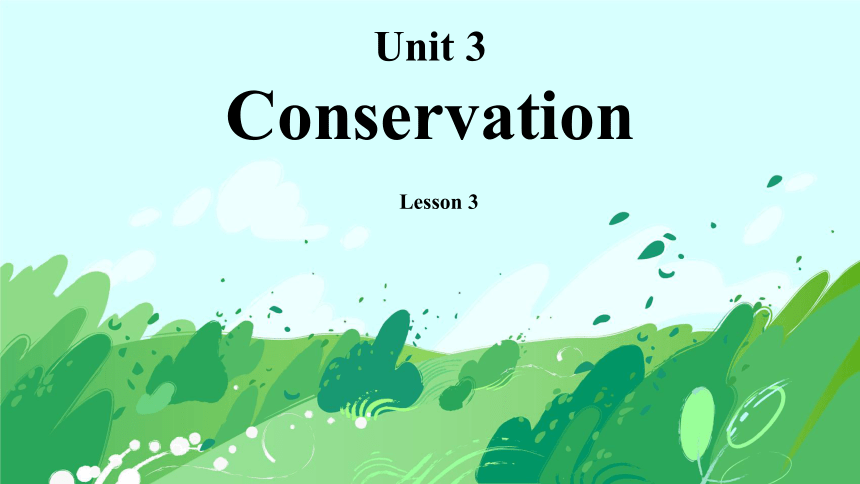 | |
| 格式 | pptx | ||
| 文件大小 | 31.4MB | ||
| 资源类型 | 教案 | ||
| 版本资源 | 北师大版(2019) | ||
| 科目 | 英语 | ||
| 更新时间 | 2025-08-01 10:21:41 | ||
图片预览

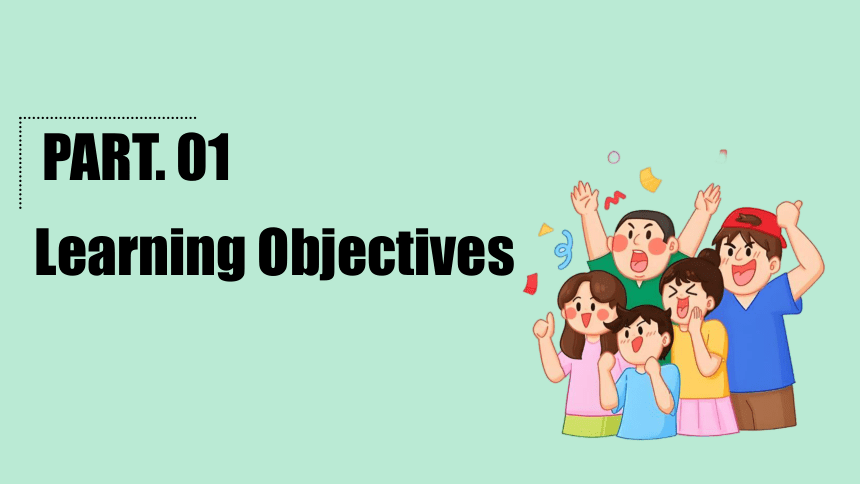
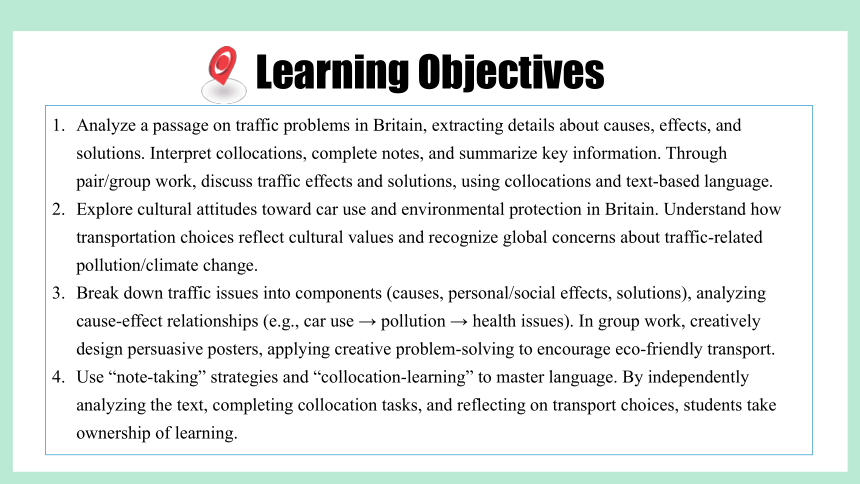
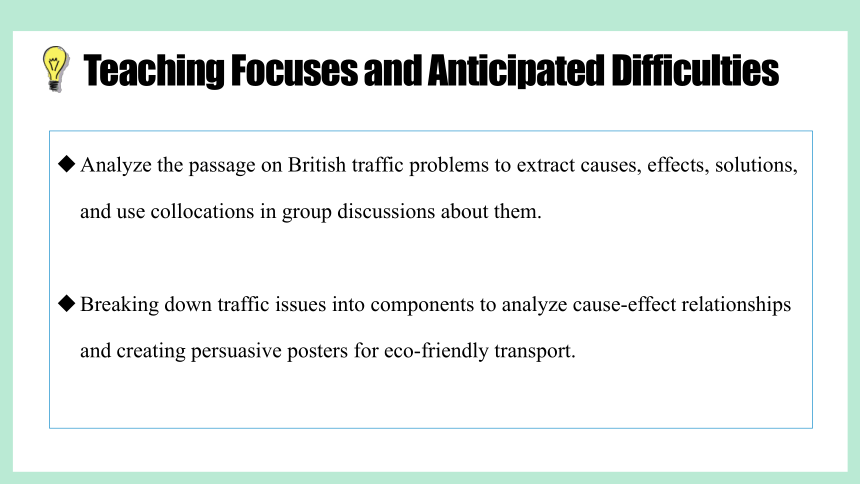
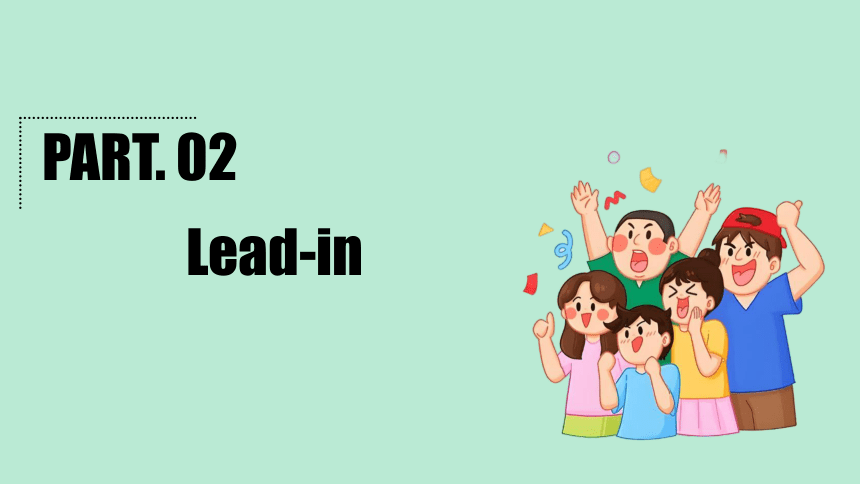
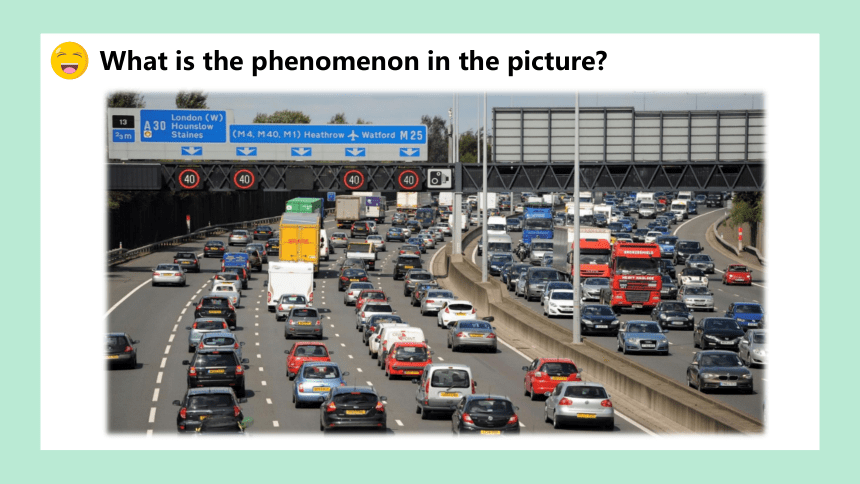
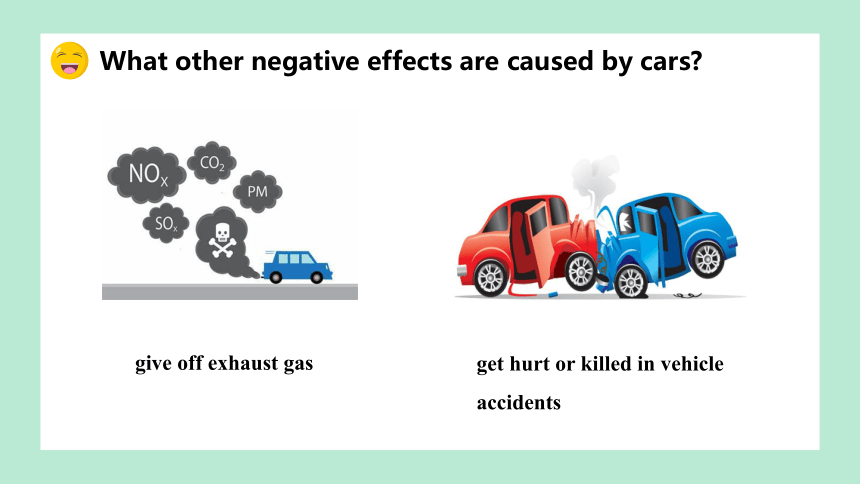
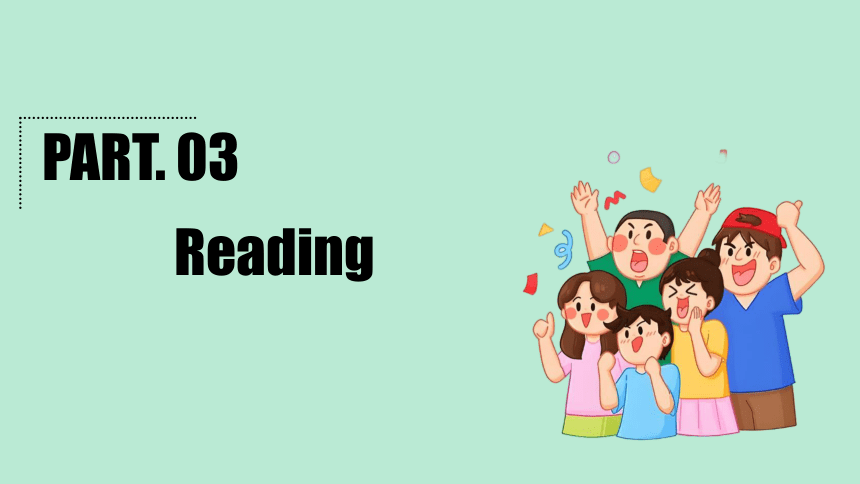
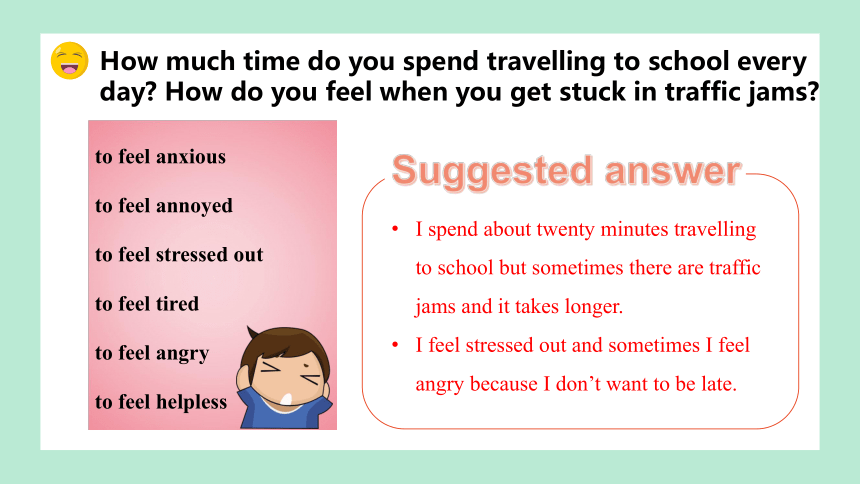

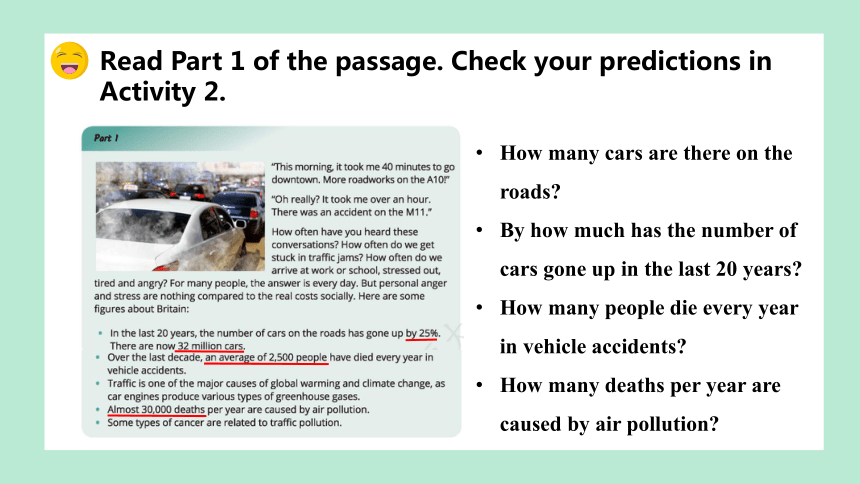
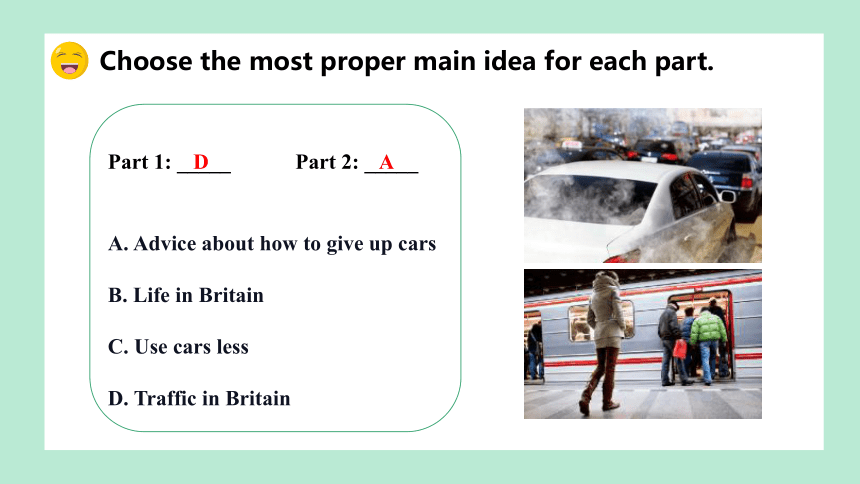
文档简介
(共36张PPT)
Lesson 3
Unit 3
Conservation
Learning Objectives
PART. 01
Understand the daily study and life of British middle school students by watching videos. Based on your own daily study and life, compare the study and life in Chinese and British schools, and find out the similarities and differences between the two. Talk about your first impression of high school life, and have a preliminary perception of the study and life in the senior high school stage.
Learning Objectives
Analyze a passage on traffic problems in Britain, extracting details about causes, effects, and solutions. Interpret collocations, complete notes, and summarize key information. Through pair/group work, discuss traffic effects and solutions, using collocations and text-based language.
Explore cultural attitudes toward car use and environmental protection in Britain. Understand how transportation choices reflect cultural values and recognize global concerns about traffic-related pollution/climate change.
Break down traffic issues into components (causes, personal/social effects, solutions), analyzing cause-effect relationships (e.g., car use → pollution → health issues). In group work, creatively design persuasive posters, applying creative problem-solving to encourage eco-friendly transport.
Use “note-taking” strategies and “collocation-learning” to master language. By independently analyzing the text, completing collocation tasks, and reflecting on transport choices, students take ownership of learning.
Understand the daily study and life of British middle school students by watching videos. Based on your own daily study and life, compare the study and life in Chinese and British schools, and find out the similarities and differences between the two. Talk about your first impression of high school life, and have a preliminary perception of the study and life in the senior high school stage.
Teaching Focuses and Anticipated Difficulties
Analyze the passage on British traffic problems to extract causes, effects, solutions, and use collocations in group discussions about them.
Breaking down traffic issues into components to analyze cause-effect relationships and creating persuasive posters for eco-friendly transport.
Lead-in
PART. 02
What is the phenomenon in the picture
What other negative effects are caused by cars
give off exhaust gas
get hurt or killed in vehicle accidents
Reading
PART. 03
How much time do you spend travelling to school every day How do you feel when you get stuck in traffic jams
to feel anxious
to feel annoyed
to feel stressed out
to feel tired
to feel angry
to feel helpless
I spend about twenty minutes travelling to school but sometimes there are traffic jams and it takes longer.
I feel stressed out and sometimes I feel angry because I don’t want to be late.
Suggested answer
Below is a passage about car uses in Britain. Guess the answers to the questions before you read the passage.
How many cars are there on the roads
32 million / 50 million / 64 million
By how much has the number of cars gone up in the last 20 years
10% / 25% / 40%
How many people die every year in vehicle accidents
1,000 / 2,500 / 3,000
How many deaths per year are caused by air pollution
10,000 / 20,000 / 30,000
Read Part 1 of the passage. Check your predictions in Activity 2.
How many cars are there on the roads
By how much has the number of cars gone up in the last 20 years
How many people die every year in vehicle accidents
How many deaths per year are caused by air pollution
Choose the most proper main idea for each part.
Part 1: _____ Part 2: _____
A. Advice about how to give up cars
B. Life in Britain
C. Use cars less
D. Traffic in Britain
D
A
Read the Part 1 fast and judge the following statements TRUE or FALSE.
( ) People always get stuck in traffic jams every day.
( ) Twenty years ago, there were 32 million cars on the road in Britain.
( ) 2,500 people die every year in vehicle accidents in the world on average.
( ) Air pollution and cancer are related to traffic.
T
F
F
T
Choose the best answer for the following questions according to Part 2.
1. Why does the writer mention the excuses in the first paragraph
A. To show us that cars are bad for us.
B. To find the cause of being late.
C. To give a reason for using cars.
D. To complain the traffic jams.
2. What’s the advantage of taking public transport
A. Saving your time. B. Helping you live longer.
C. Keeping you fit. D. Relaxing yourself.
Choose the best answer for the following questions according to Part 2.
3. What can we know from the advice on how to give up cars from the author’s friend
A. Use our legs regularly to prevent heart disease.
B. Reduce the unnecessary journey.
C. Share cars with someone else all the time.
D. Use public transport to save money.
4. What can we infer about the writer from the last paragraph
A. He can’t go without cars. B. He has a beautiful daughter.
C. He give his son a busy schedule. D. He will take action immediately.
Read Part 1 more carefully. Complete the notes in the diagram. Then think about any possible solutions to the problems.
Taking Notes (2)
Taking notes when reading a text is very similar to taking notes when listening (see Book 3, Unit 8).
Read the text quickly to get the general idea of the text.
Decide what kind of information you are looking for, e.g. names, places, dates, events, reasons, feelings or numbers.
Remember: Don’t try to write in full sentences; use abbreviations and symbols.
Skill Builder
Read Part 1 more carefully. Complete the notes in the diagram. Then think about any possible solutions to the problems.
Traffic
problems
Effects: personal
angry
Effects: social
Possible solutions:
ride a bike
take public transportation
...
stressed out
tired
traffic accidents
global warming and climate change
deaths and cancer caused by air pollution
Read Part 2 and complete the notes.
Solutions / Advice
walk / cycle more
use public transport
think before you go
share cars
t ake action
Pair Work Talk about the effects of traffic problems at the personal and social level, as well as the solutions proposed. Then discuss whether the solutions will help solve the problem. Give your reasons. Use the notes in Activities 4 and 5 to help you.
Nobody likes being in a traffic jam. The personal effects like getting angry or being stressed out can lead to more serious problems, like becoming sick or losing your job. Being on the road can also be dangerous as there are many accidents, and the amount of pollution that traffic causes can also give us health problems. Then, there are the environmental effects to our planet, such as global warming. The solutions could be to try to use the car less. We can cycle, walk or use public transport. We can also share our cars. These are simple solutions that we can all do.
Suggested answer
Think & share
What is the writer’s attitude towards cars Find some evidence from the passage.
The writer knows that cars have negative effects and he / she wants to help the environment (“We know that cars are bad for us.” “All quite simple, isn’t it Five easy ways to improve our environment.”) but he / she thinks it will be difficult for him / her to give up his / her car (“I’ve got to pick up my daughter form school... The traffic is going to be horrible, but what can I do ”).
Think & share
How do you understand the title “The Road to Destruction”
The title “The road to destruction” refers to the fact that the cars on the road will eventually lead to the destruction of our planet.
Look at the Word Builder. Match the words (1-8) with the endings (a-h) to form common collocations. Then use the collocations to complete the summary.
Collocations (2)
Word Builder
1 make
2 get stuck
3 be
4 protect
5 do
6 pick
7 cause
8 share
a addicted to
b a lot of harm
c cars
d in a traffic jam
e up sb
f the environment
g excuses
h global warming
make excuses
get stuck in a traffic jam
be addicted to
protect the environment
do a lot of harm
pick up sb
cause global warming
share cars
Look at the Word Builder. Match the words (1-8) with the endings (a-h) to form common collocations. Then use the collocations to complete the summary.
make excuses get stuck in a traffic jam be addicted to protect the environment
do a lot of harm pick up sb cause global warming share cars
Many people often 1______________________ when they go to work. How annoyed and stressed they often feel! But the problem is that the number of cars is still going up. Traffic pollution has been found to 2____________________ and climate change to a large degree.
Too many cars 3_________________ to the environment and our health. Some advice has been given for people to help 4______________________, for example, using public transport or 5_____________, doing your shopping in the shop just around the corner instead of driving to the other side of town. However, people 6_________________ using cars. They 7_______________ for using their cars, “I need to 8_____________ my daughter. What can I do ”
get stuck in a traffic jam
cause global warming
do a lot of harm
protect the environment
sharing cars
are addicted to
make excuses
pick up
Make a poster based on what you have learnt to encourage people in your neighbourhood to use their vehicles wisely. Search for facts and data to make your poster convincing. Then share your work in groups.
Vocabulary
1. annoyed
be annoyed with sb. 对某人感到恼怒
be annoyed at/about sth. 因某事生气
be annoyed to do/that... 因……而恼火
annoying adj. 使生气的;使烦恼的
annoyance n. 烦恼;生气;令人烦恼的事
例题:
The __________(annoy) thing about online shopping is waiting for deliveries that arrive later than promised.
annoying
Vocabulary
2. relate
relate... to... 把……和……联系起来
be related to 与……有关联
relate to... 涉及,与……相关,谈到;能够理解并同情
relation n. 关系;亲戚
in relation to 关于……;与……相比较
例题:
Many common diseases, such as heart problems and diabetes, are related _______ unhealthy habits like poor diet and lack of exercise.
to
Vocabulary
3. suit
suit sth. to sb. 使某物适合于某人
suit oneself 随自己的意愿行事;自便
suitable adj. 合适的;适宜的
be suitable for 适合
be suitable to do sth 适合做某事
例题:
The camp organizers suited the activities _______ the kids’ ages, planning craft projects for younger children and hiking trips for teenagers.
to
Exercise
PART. 04
1. Scientists warn that if we don’t reduce carbon emissions in the next d_______(十年), the effects of climate change will become irreversible.
2. Many students get s_______(卡住的) when writing essays, struggling to find the right words to express their ideas.
3. The sudden heavy rain caused a serious traffic j______(堵塞), forcing many people to spend the night in their cars.
4. The campaign aims to raise awareness about the d___________(破坏) caused by single-use plastics in our oceans.
ecade
Exercise: 单词拼写
tuck
am
estruction
1. While ________(angry) is a natural reaction to injustice, holding onto it can harm one’s mental health more than the original hurt.
2. Her patience and communication skills make her _________(suit) for a career in teaching, where connecting with students is essential.
3. The old clock works perfectly because its owner cleans and oils it __________ (regular), preventing dust and rust from damaging the parts.
4. She was _________(annoy) by the constant noise from the construction site next door, which made it hard to focus on her homework.
anger
Exercise: 用所给词的适当形式填空
suitable
regularly
annoyed
Summary
PART. 05
添加标题
ADD THE TITLE HERE
Lesson 3
Vocabulary
Analyze the traffic problems in Britain, extracting details about causes, effects, and solutions.
Explore cultural attitudes toward car use and environmental protection in Britain.
Reading
annoyed, relate, suit
Homework
PART. 06
Use the language you have learnt to write a “for” and “against” essay on the use of vehicles.
Homework
See you next class!
Lesson 3
Unit 3
Conservation
Learning Objectives
PART. 01
Understand the daily study and life of British middle school students by watching videos. Based on your own daily study and life, compare the study and life in Chinese and British schools, and find out the similarities and differences between the two. Talk about your first impression of high school life, and have a preliminary perception of the study and life in the senior high school stage.
Learning Objectives
Analyze a passage on traffic problems in Britain, extracting details about causes, effects, and solutions. Interpret collocations, complete notes, and summarize key information. Through pair/group work, discuss traffic effects and solutions, using collocations and text-based language.
Explore cultural attitudes toward car use and environmental protection in Britain. Understand how transportation choices reflect cultural values and recognize global concerns about traffic-related pollution/climate change.
Break down traffic issues into components (causes, personal/social effects, solutions), analyzing cause-effect relationships (e.g., car use → pollution → health issues). In group work, creatively design persuasive posters, applying creative problem-solving to encourage eco-friendly transport.
Use “note-taking” strategies and “collocation-learning” to master language. By independently analyzing the text, completing collocation tasks, and reflecting on transport choices, students take ownership of learning.
Understand the daily study and life of British middle school students by watching videos. Based on your own daily study and life, compare the study and life in Chinese and British schools, and find out the similarities and differences between the two. Talk about your first impression of high school life, and have a preliminary perception of the study and life in the senior high school stage.
Teaching Focuses and Anticipated Difficulties
Analyze the passage on British traffic problems to extract causes, effects, solutions, and use collocations in group discussions about them.
Breaking down traffic issues into components to analyze cause-effect relationships and creating persuasive posters for eco-friendly transport.
Lead-in
PART. 02
What is the phenomenon in the picture
What other negative effects are caused by cars
give off exhaust gas
get hurt or killed in vehicle accidents
Reading
PART. 03
How much time do you spend travelling to school every day How do you feel when you get stuck in traffic jams
to feel anxious
to feel annoyed
to feel stressed out
to feel tired
to feel angry
to feel helpless
I spend about twenty minutes travelling to school but sometimes there are traffic jams and it takes longer.
I feel stressed out and sometimes I feel angry because I don’t want to be late.
Suggested answer
Below is a passage about car uses in Britain. Guess the answers to the questions before you read the passage.
How many cars are there on the roads
32 million / 50 million / 64 million
By how much has the number of cars gone up in the last 20 years
10% / 25% / 40%
How many people die every year in vehicle accidents
1,000 / 2,500 / 3,000
How many deaths per year are caused by air pollution
10,000 / 20,000 / 30,000
Read Part 1 of the passage. Check your predictions in Activity 2.
How many cars are there on the roads
By how much has the number of cars gone up in the last 20 years
How many people die every year in vehicle accidents
How many deaths per year are caused by air pollution
Choose the most proper main idea for each part.
Part 1: _____ Part 2: _____
A. Advice about how to give up cars
B. Life in Britain
C. Use cars less
D. Traffic in Britain
D
A
Read the Part 1 fast and judge the following statements TRUE or FALSE.
( ) People always get stuck in traffic jams every day.
( ) Twenty years ago, there were 32 million cars on the road in Britain.
( ) 2,500 people die every year in vehicle accidents in the world on average.
( ) Air pollution and cancer are related to traffic.
T
F
F
T
Choose the best answer for the following questions according to Part 2.
1. Why does the writer mention the excuses in the first paragraph
A. To show us that cars are bad for us.
B. To find the cause of being late.
C. To give a reason for using cars.
D. To complain the traffic jams.
2. What’s the advantage of taking public transport
A. Saving your time. B. Helping you live longer.
C. Keeping you fit. D. Relaxing yourself.
Choose the best answer for the following questions according to Part 2.
3. What can we know from the advice on how to give up cars from the author’s friend
A. Use our legs regularly to prevent heart disease.
B. Reduce the unnecessary journey.
C. Share cars with someone else all the time.
D. Use public transport to save money.
4. What can we infer about the writer from the last paragraph
A. He can’t go without cars. B. He has a beautiful daughter.
C. He give his son a busy schedule. D. He will take action immediately.
Read Part 1 more carefully. Complete the notes in the diagram. Then think about any possible solutions to the problems.
Taking Notes (2)
Taking notes when reading a text is very similar to taking notes when listening (see Book 3, Unit 8).
Read the text quickly to get the general idea of the text.
Decide what kind of information you are looking for, e.g. names, places, dates, events, reasons, feelings or numbers.
Remember: Don’t try to write in full sentences; use abbreviations and symbols.
Skill Builder
Read Part 1 more carefully. Complete the notes in the diagram. Then think about any possible solutions to the problems.
Traffic
problems
Effects: personal
angry
Effects: social
Possible solutions:
ride a bike
take public transportation
...
stressed out
tired
traffic accidents
global warming and climate change
deaths and cancer caused by air pollution
Read Part 2 and complete the notes.
Solutions / Advice
walk / cycle more
use public transport
think before you go
share cars
t ake action
Pair Work Talk about the effects of traffic problems at the personal and social level, as well as the solutions proposed. Then discuss whether the solutions will help solve the problem. Give your reasons. Use the notes in Activities 4 and 5 to help you.
Nobody likes being in a traffic jam. The personal effects like getting angry or being stressed out can lead to more serious problems, like becoming sick or losing your job. Being on the road can also be dangerous as there are many accidents, and the amount of pollution that traffic causes can also give us health problems. Then, there are the environmental effects to our planet, such as global warming. The solutions could be to try to use the car less. We can cycle, walk or use public transport. We can also share our cars. These are simple solutions that we can all do.
Suggested answer
Think & share
What is the writer’s attitude towards cars Find some evidence from the passage.
The writer knows that cars have negative effects and he / she wants to help the environment (“We know that cars are bad for us.” “All quite simple, isn’t it Five easy ways to improve our environment.”) but he / she thinks it will be difficult for him / her to give up his / her car (“I’ve got to pick up my daughter form school... The traffic is going to be horrible, but what can I do ”).
Think & share
How do you understand the title “The Road to Destruction”
The title “The road to destruction” refers to the fact that the cars on the road will eventually lead to the destruction of our planet.
Look at the Word Builder. Match the words (1-8) with the endings (a-h) to form common collocations. Then use the collocations to complete the summary.
Collocations (2)
Word Builder
1 make
2 get stuck
3 be
4 protect
5 do
6 pick
7 cause
8 share
a addicted to
b a lot of harm
c cars
d in a traffic jam
e up sb
f the environment
g excuses
h global warming
make excuses
get stuck in a traffic jam
be addicted to
protect the environment
do a lot of harm
pick up sb
cause global warming
share cars
Look at the Word Builder. Match the words (1-8) with the endings (a-h) to form common collocations. Then use the collocations to complete the summary.
make excuses get stuck in a traffic jam be addicted to protect the environment
do a lot of harm pick up sb cause global warming share cars
Many people often 1______________________ when they go to work. How annoyed and stressed they often feel! But the problem is that the number of cars is still going up. Traffic pollution has been found to 2____________________ and climate change to a large degree.
Too many cars 3_________________ to the environment and our health. Some advice has been given for people to help 4______________________, for example, using public transport or 5_____________, doing your shopping in the shop just around the corner instead of driving to the other side of town. However, people 6_________________ using cars. They 7_______________ for using their cars, “I need to 8_____________ my daughter. What can I do ”
get stuck in a traffic jam
cause global warming
do a lot of harm
protect the environment
sharing cars
are addicted to
make excuses
pick up
Make a poster based on what you have learnt to encourage people in your neighbourhood to use their vehicles wisely. Search for facts and data to make your poster convincing. Then share your work in groups.
Vocabulary
1. annoyed
be annoyed with sb. 对某人感到恼怒
be annoyed at/about sth. 因某事生气
be annoyed to do/that... 因……而恼火
annoying adj. 使生气的;使烦恼的
annoyance n. 烦恼;生气;令人烦恼的事
例题:
The __________(annoy) thing about online shopping is waiting for deliveries that arrive later than promised.
annoying
Vocabulary
2. relate
relate... to... 把……和……联系起来
be related to 与……有关联
relate to... 涉及,与……相关,谈到;能够理解并同情
relation n. 关系;亲戚
in relation to 关于……;与……相比较
例题:
Many common diseases, such as heart problems and diabetes, are related _______ unhealthy habits like poor diet and lack of exercise.
to
Vocabulary
3. suit
suit sth. to sb. 使某物适合于某人
suit oneself 随自己的意愿行事;自便
suitable adj. 合适的;适宜的
be suitable for 适合
be suitable to do sth 适合做某事
例题:
The camp organizers suited the activities _______ the kids’ ages, planning craft projects for younger children and hiking trips for teenagers.
to
Exercise
PART. 04
1. Scientists warn that if we don’t reduce carbon emissions in the next d_______(十年), the effects of climate change will become irreversible.
2. Many students get s_______(卡住的) when writing essays, struggling to find the right words to express their ideas.
3. The sudden heavy rain caused a serious traffic j______(堵塞), forcing many people to spend the night in their cars.
4. The campaign aims to raise awareness about the d___________(破坏) caused by single-use plastics in our oceans.
ecade
Exercise: 单词拼写
tuck
am
estruction
1. While ________(angry) is a natural reaction to injustice, holding onto it can harm one’s mental health more than the original hurt.
2. Her patience and communication skills make her _________(suit) for a career in teaching, where connecting with students is essential.
3. The old clock works perfectly because its owner cleans and oils it __________ (regular), preventing dust and rust from damaging the parts.
4. She was _________(annoy) by the constant noise from the construction site next door, which made it hard to focus on her homework.
anger
Exercise: 用所给词的适当形式填空
suitable
regularly
annoyed
Summary
PART. 05
添加标题
ADD THE TITLE HERE
Lesson 3
Vocabulary
Analyze the traffic problems in Britain, extracting details about causes, effects, and solutions.
Explore cultural attitudes toward car use and environmental protection in Britain.
Reading
annoyed, relate, suit
Homework
PART. 06
Use the language you have learnt to write a “for” and “against” essay on the use of vehicles.
Homework
See you next class!
同课章节目录
- Unit 1 Relationshis
- Lesson 1 Teachers
- Lesson 2 How Do We Like Teachers’ Feedback?
- Lesson 3 So Close,Yet So Fa
- Unit 2 Success
- Lesson 1 Money vs Success
- Lesson 2 Top Five Secrets of Success
- Lesson 3 Getting to the Top
- Unit 3 Conservation
- Lesson 1 The Sixth Extinction
- Lesson 2 War on Plastic Packets
- Lesson 3 The Road to Destruction
